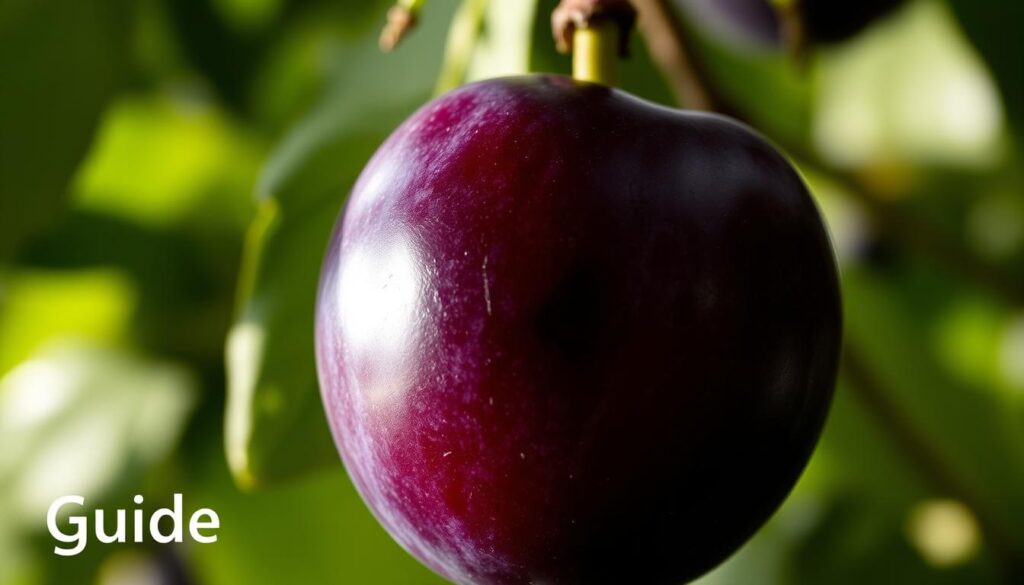As the summer months approach, the sweet and juicy plum becomes a staple in many American households. Rich in Vitamin C and antioxidants, plums are not only a delicious addition to various dishes but also a nutritious choice for those looking to enhance their health.
Available from June to October, plums offer a versatile culinary experience, from being a great snack on their own to being a fantastic addition to salads, baked goods, and savory dishes. Whether you’re looking to indulge in the luxury of curated accommodation or simply enjoy a healthy snack, understanding how to choose and use plums can elevate your culinary adventures.
Key Takeaways
- Understand the best seasons for plum availability.
- Learn how to select the perfect plum.
- Discover various culinary uses for plums.
- Explore the nutritional benefits of incorporating plums into your diet.
- Get tips on storing plums to maintain their freshness.
Introduction to Plums
With hundreds of varieties, plums offer a diverse culinary experience, from sweet treats to tangy delights. This diversity allows plums to be enjoyed in numerous settings, whether at home or in premium lodging options where exotic plum varieties are served.
Plums come in a range of colors and flavors, making them a versatile ingredient for various dishes. They can be savored fresh, used in baking, or as a topping for desserts. For travelers, trusted travel reviews often highlight destinations where local plum specialties can be enjoyed.
The versatility of plums is not just limited to their taste; they are also rich in nutrients, making them a healthy addition to any meal. Whether you’re a food enthusiast or a traveler looking to explore local cuisine, plums are a fruit worth discovering.
Nutritional Benefits of Plums
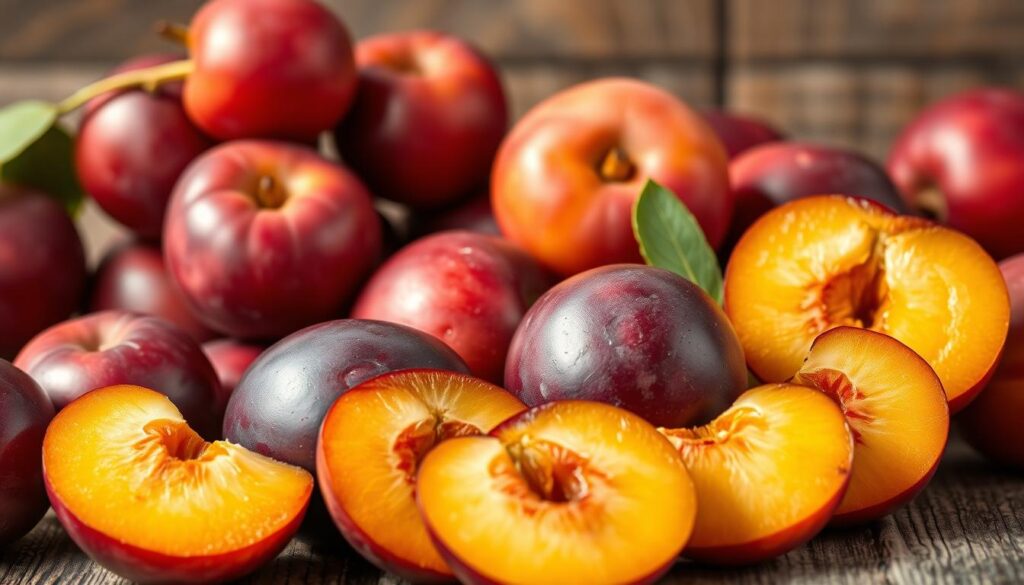
The nutritional profile of plums makes them an excellent choice for those seeking to improve their overall health. Plums are rich in essential nutrients, including vitamins, minerals, and antioxidants, which contribute to their numerous health benefits.
Vitamins and Minerals Found in Plums
Plums are an excellent source of Vitamin C, a vital nutrient that plays a significant role in immune function and overall health. They also contain other essential vitamins and minerals, such as potassium and copper, which are important for maintaining healthy blood pressure and supporting various bodily functions.
“Eating a diet rich in fruits like plums can have a significant impact on our health,” as noted by nutrition experts. The antioxidants found in plums help protect against oxidative stress and inflammation, potentially reducing the risk of chronic diseases.
Fiber Content and Health Benefits
One of the key nutritional benefits of plums is their high fiber content. Fiber is crucial for digestive health, promoting regular bowel movements and preventing constipation. A diet high in fiber can also help manage blood sugar levels and support healthy weight management.
Incorporating plums into your diet can be a delicious way to boost your fiber intake. Whether enjoyed fresh, dried, or cooked into various dishes, plums can be a versatile and nutritious addition to meals, even when you’re on exclusive travel experiences or enjoying top-rated holiday rentals.
Different Varieties of Plums
With a rich diversity in plum varieties, consumers can choose between European and Japanese types, each with its unique characteristics. This diversity allows for a wide range of uses, from enjoying plums fresh to incorporating them into various recipes, whether you’re at home or in high-end travel accommodations.
European vs. Japanese Plums
European plums are often preferred for drying due to their higher sugar content and firmer flesh, making them ideal for prunes. On the other hand, Japanese plums are typically eaten fresh because of their juicy texture and sweet flavor profile.
| Characteristics | European Plums | Japanese Plums |
|---|---|---|
| Primary Use | Drying/Prunes | Fresh Consumption |
| Texture | Firm | Juicy |
| Flavor Profile | Sweet, rich | Sweet, tart |
Sweet and Tart Flavors
Plums are known for their diverse flavor profiles, ranging from sweet to tart. Sweet plums are perfect for fresh eating, while tart plums are often used in cooking and baking, adding a unique flavor dimension to dishes. Whether you’re planning a culinary experience at a personalized vacation rental or at home, understanding these flavor profiles can enhance your plum-eating experience.
Seasonal Availability of Plums
The availability of plums varies by season and region. Generally, plum season starts in late spring and continues through early fall, with the peak season usually occurring in the summer months. Being aware of the seasonal availability can help you enjoy plums at their best, whether you’re incorporating them into your meals at home or as part of a culinary experience during your stay in high-end travel accommodations.
How to Choose the Perfect Plum
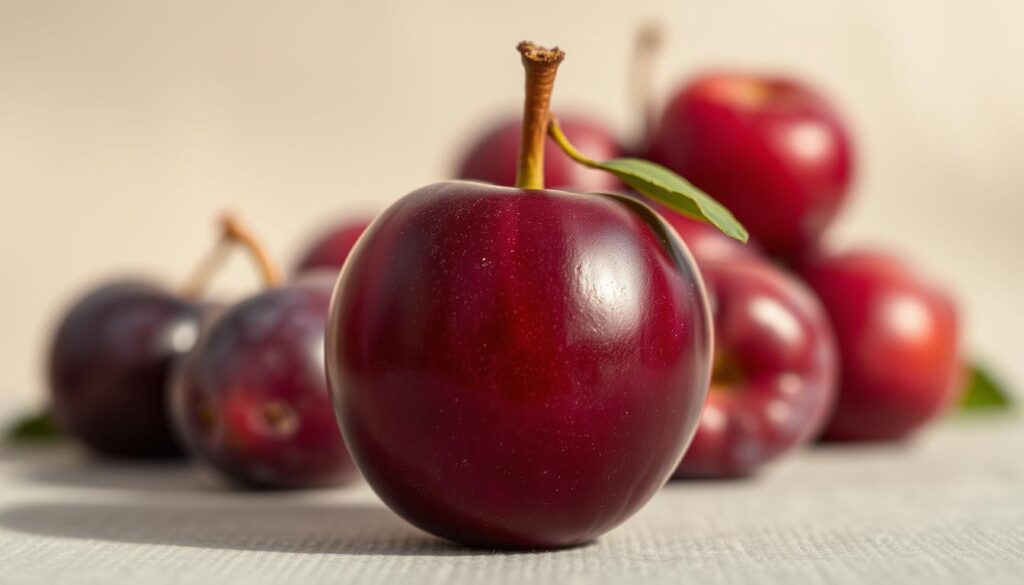
To fully appreciate the flavor and nutritional benefits of plums, it’s essential to know how to pick the right one. Whether you’re planning to enjoy them during your stay at a curated accommodation or simply looking for a healthy snack, selecting the perfect plum is crucial.
Characteristics of Ripeness
A ripe plum is characterized by its slightly soft skin and sweet aroma. When selecting plums, look for fruits with unblemished skin and a slight give when pressed, similar to a ripe peach or avocado. Avoid plums that are too soft or have visible bruises.
- Check for a sweet, fruity aroma; a ripe plum should have a noticeable but not overpowering scent.
- Gently press the skin; a ripe plum yields to pressure but should still feel firm enough.
- Avoid plums with signs of decay or mold.
Sourcing Plums at the Grocery Store
When sourcing plums at a grocery store, it’s essential to inspect the fruit carefully. Most grocery stores receive plum shipments regularly, but the quality can vary. Look for plums that are stored properly, ideally at room temperature or slightly cooled, to prolong freshness.
- Check the plum’s color; while some varieties remain green when ripe, many turn from green to a yellow, red, or purple hue.
- Ensure the plums are not too hard or too soft.
- Consider purchasing plums that are slightly underripe, as they will continue to ripen at home.
Tips for Picking Plums at a Farmers Market
Farmers markets can be an excellent place to find a variety of plum types and often offer the chance to taste before you buy. When picking plums at a farmers market, ask the vendor about the different varieties available and their ripening characteristics.
Key tips:
- Taste a plum if possible to gauge its sweetness and flavor profile.
- Inquire about the plum variety and its best use (e.g., eating fresh, baking, or cooking).
- Consider the price and value; often, farmers markets offer competitive pricing for fresh, locally grown produce.
By following these guidelines, you’ll be well on your way to selecting the perfect plum for any occasion, whether you’re enjoying it as part of a plum guide-recommended recipe or savoring it on its own.
Proper Storage of Plums
Proper storage is key to enjoying plums at their best, whether you’re savoring them as a snack or using them in your favorite recipes. When traveling in luxury travel accommodations, having fresh plums can be a delightful treat, and with the right storage, you can enjoy them for longer.
Best Practices for Short-Term Storage
For short-term storage, plums should be kept at room temperature until they ripen. To speed up the ripening process, you can store them in a loosely closed paper bag. Once ripe, plums can be refrigerated to prolong their freshness. It’s essential to check on them regularly to ensure they don’t spoil.
According to trusted travel reviews, storing plums in the refrigerator can keep them fresh for up to 5 days. Make sure to store them away from strong-smelling foods, as plums can absorb odors easily.
Long-Term Storage Options
For long-term storage, plums can be frozen or canned. To freeze plums, simply wash, dry, and chop them, then spread them out on a baking sheet and place it in the freezer. Once frozen, transfer them to airtight containers or freezer bags for storage. Canning is another excellent option, involving packing plums into sterilized jars and processing them in a boiling water bath.
| Storage Method | Duration | Notes |
|---|---|---|
| Room Temperature | Until ripe | Speeds up ripening |
| Refrigeration | Up to 5 days | Prolongs freshness |
| Freezing | Several months | Best for long-term storage |
| Canning | Up to a year | Requires sterilized jars and processing |
Signs of Spoilage to Watch For
It’s crucial to monitor plums for signs of spoilage, especially when storing them for extended periods. Look out for mold, soft spots, or an off smell. As one expert notes,
“The best way to ensure your plums stay fresh is to check on them regularly and remove any that show signs of spoilage.”
By following these storage tips, you can enjoy your plums for longer, whether you’re at home or enjoying luxury travel accommodations.
Creative Ways to Use Plums in Cooking
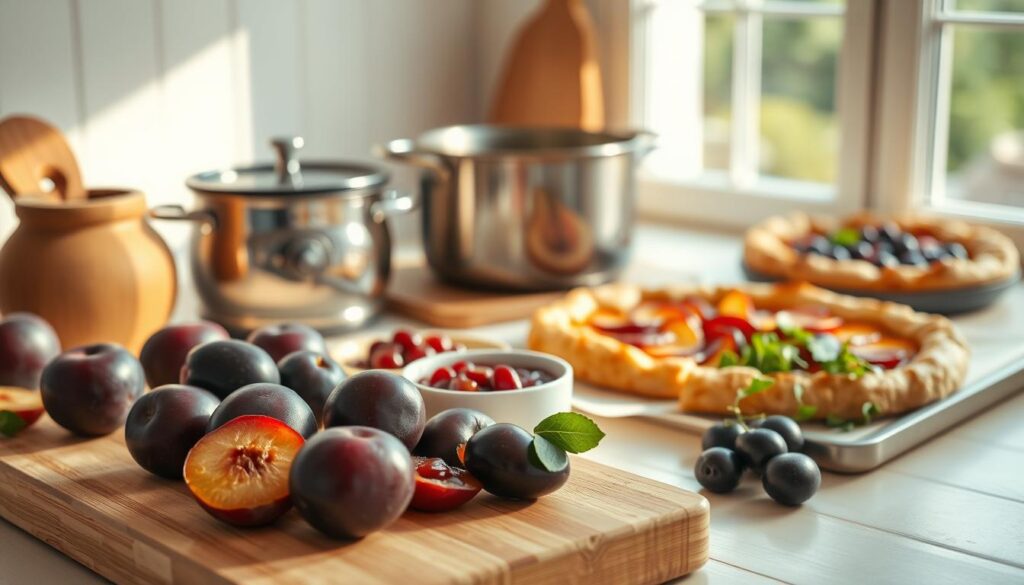
From sauces to baked goods, plums offer a wide range of culinary possibilities. Whether you’re looking to add a tangy twist to your savory dishes or a sweet burst to your desserts, plums are a versatile ingredient that can elevate your cooking.
Plum-Based Sauces and Condiments
Plums can be transformed into delicious sauces and condiments that complement a variety of dishes. For instance, a plum chutney can be a great accompaniment to grilled meats or cheeses. To make a simple plum sauce, combine plums, onions, and a hint of ginger in a saucepan, and simmer until the mixture thickens.
Here are some ideas for plum-based sauces and condiments:
- Plum chutney with grilled meats or cheeses
- Plum BBQ sauce for a sweet and tangy twist
- Plum salsa for a fresh and spicy kick
| Sauce/Condiment | Main Ingredients | Pairing Suggestions |
|---|---|---|
| Plum Chutney | Plums, Onions, Ginger | Grilled Meats, Cheeses |
| Plum BBQ Sauce | Plums, Tomato Sauce, Vinegar | Ribs, Grilled Chicken |
| Plum Salsa | Plums, Onions, Jalapeños | Tacos, Grilled Fish |
Baking with Plums: Recipes and Tips
Plums are a fantastic addition to baked goods, adding natural sweetness and moisture. When baking with plums, it’s essential to choose the right variety. Sweet plums like Santa Rosa are ideal for desserts, while tart plums like Italian Prune can add a nice balance to sweet baked goods.
Here are some tips for baking with plums:
- Use ripe but firm plums for the best results
- Adjust the amount of sugar based on the plum’s sweetness
- Combine plums with spices like cinnamon or nutmeg for added depth
By incorporating plums into your cooking and baking, you can create dishes that are not only delicious but also visually appealing, much like the exclusive travel experiences that leave a lasting impression. Whether you’re hosting guests at a top-rated holiday rental or simply enjoying a meal with family, plums can elevate your culinary creations.
Plums in Beverages
From juices to cocktails, plums add a unique flavor to drinks. Whether you’re relaxing at home or enjoying premium lodging options during your vacation, plum-based beverages can be a refreshing choice.
Plum Juices and Smoothies
Plum juice is a delicious and healthy drink that can be enjoyed on its own or blended with other fruits to create a tasty smoothie. The natural sweetness of plums makes them an excellent base for smoothies, especially when combined with ingredients like yogurt or milk.
Tips for making plum smoothies:
- Combine plums with your favorite fruits for a unique flavor.
- Add a splash of citrus juice for extra brightness.
- Use plums as a topping for your smoothie bowl.
Cocktails Featuring Plums
Plums can also be used to create delicious and sophisticated cocktails. The sweetness of plums pairs well with a variety of spirits, making them a versatile ingredient for mixologists.
“Plums bring a depth of flavor to cocktails that is hard to match with other fruits.” – Mixology Expert
Some ideas for plum cocktails include:
- Plum martini: Blend plums with vodka and a touch of lime juice.
- Plum spritzer: Mix plum juice with sparkling wine and a splash of grenadine.
- Plum old fashioned: Infuse bourbon with plums and a hint of cinnamon.
Enjoying plum-based beverages in the comfort of your own home or at personalized vacation rentals can be a truly delightful experience. Whether you’re sipping on a plum smoothie or savoring a plum cocktail, the unique flavor of plums is sure to impress.
Preserving Plums: Canning and Freezing
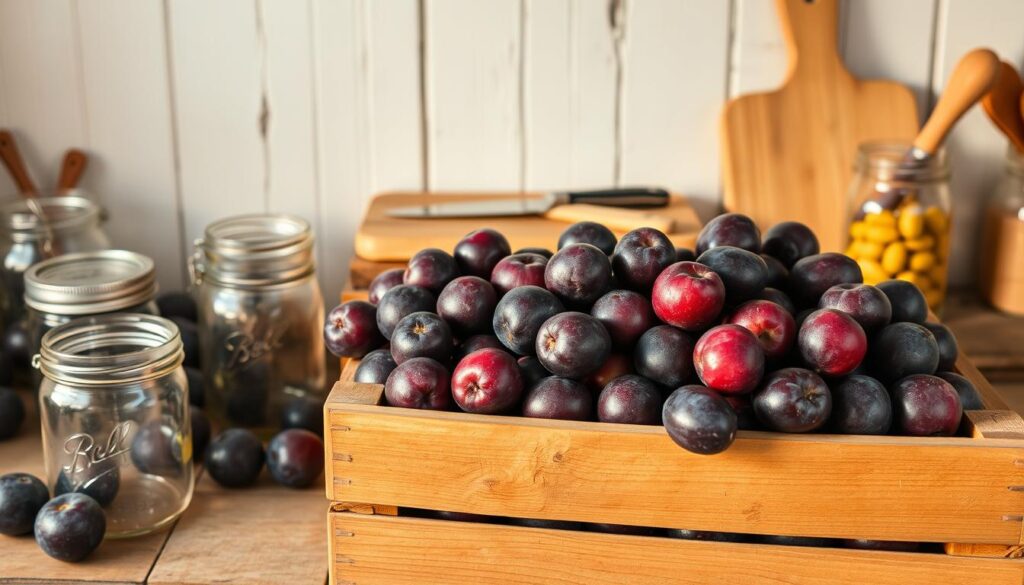
Preserving plums is a fantastic way to enjoy their flavor and nutritional benefits throughout the year. Whether you’re enjoying a relaxing getaway in high-end travel accommodations or simply savoring a meal at home, having preserved plums on hand can elevate your culinary experiences. Canning and freezing are two effective methods for preserving plums, allowing you to savor their taste and health benefits in any setting.
Step-by-Step Guide to Canning Plums
Canning plums is a straightforward process that requires some basic equipment and attention to detail. To start, you’ll need to prepare your plums by washing, peeling, and slicing them. For a detailed guide on the canning process, you can visit the Oregon State University Extension Service website, which provides comprehensive instructions and safety tips.
Here’s a brief overview of the canning process:
- Prepare your canning jars and lids by sterilizing them in boiling water.
- Pack the prepared plums into the hot jars, leaving the recommended headspace.
- Add a syrup or juice to the jar, if desired, to enhance the flavor.
- Seal the jars and process them in a boiling water bath to ensure they are properly sterilized and sealed.
As noted by the USDA, “Canning is a safe and effective way to preserve fruits and vegetables, as long as it’s done correctly.” Proper canning techniques can help you enjoy your plums year-round.
Freezing Plums for Year-Round Use
Freezing is another excellent method for preserving plums. It’s a simple process that helps retain the fruit’s flavor and nutrients. To freeze plums, start by washing, peeling, and chopping them. You can then blanch the chopped plums in boiling water for a few seconds to inactivate the enzymes that cause spoilage.
After blanching, immediately plunge the plums into an ice bath to stop the cooking process. Once cooled, package the plums in airtight containers or freezer bags, making sure to remove as much air as possible before sealing. Label the containers with the date and contents, and store them in the freezer at 0°F (-18°C) or below.
As Bon Appétit suggests, “Frozen fruits are just as versatile as fresh ones and can be used in a variety of dishes, from smoothies to baked goods.” Frozen plums can be a great addition to your kitchen, providing a burst of flavor and nutrition even in the off-season.
By preserving plums through canning and freezing, you can enjoy their delicious taste and health benefits throughout the year, whether you’re at home or staying in curated accommodations. These methods allow you to savor the flavor of plums in various dishes, from savory meals to sweet desserts, and make the most of your culinary adventures.
Health Considerations When Eating Plums
While plums are a nutritious and delicious addition to a healthy diet, there are certain health considerations to be aware of. As with any food, understanding the potential health implications can help individuals make informed choices about their diet.
Potential Allergies and Reactions
Some individuals may be allergic to plums or experience adverse reactions after consuming them. Symptoms of a plum allergy can range from mild discomfort to severe reactions. If you suspect an allergy, it’s essential to consult a healthcare professional for proper diagnosis and guidance.
For those who are not allergic, plums can still cause digestive issues in some cases, particularly when consumed in large quantities. The high fiber content in plums can lead to gastrointestinal upset, including bloating, gas, or stomach cramps in sensitive individuals.
Dietary Restrictions and Sensitivities
Individuals with specific dietary needs or restrictions should be mindful of how plums fit into their overall diet. For example, those monitoring their sugar intake should be aware that plums contain natural sugars. Additionally, individuals with certain health conditions, such as diabetes, may need to consider the glycemic index of plums as part of their meal planning.
For more detailed information on plum nutrition and health benefits, you can visit Medical News Today, which provides comprehensive insights into the nutritional value of plums.
| Health Consideration | Description | Precaution |
|---|---|---|
| Allergic Reactions | Symptoms can range from mild to severe | Consult a healthcare professional if symptoms occur |
| Digestive Issues | High fiber content can cause gastrointestinal upset | Consume in moderation, especially if sensitive |
| Dietary Restrictions | Natural sugars and glycemic index considerations | Monitor sugar intake and consider glycemic index |
By being aware of these health considerations, individuals can enjoy plums as part of a balanced and healthy diet. Whether you’re looking to incorporate plums into your daily meals or seeking to understand their nutritional benefits, being informed is key to maximizing their health benefits.
Cooking Techniques for Plums
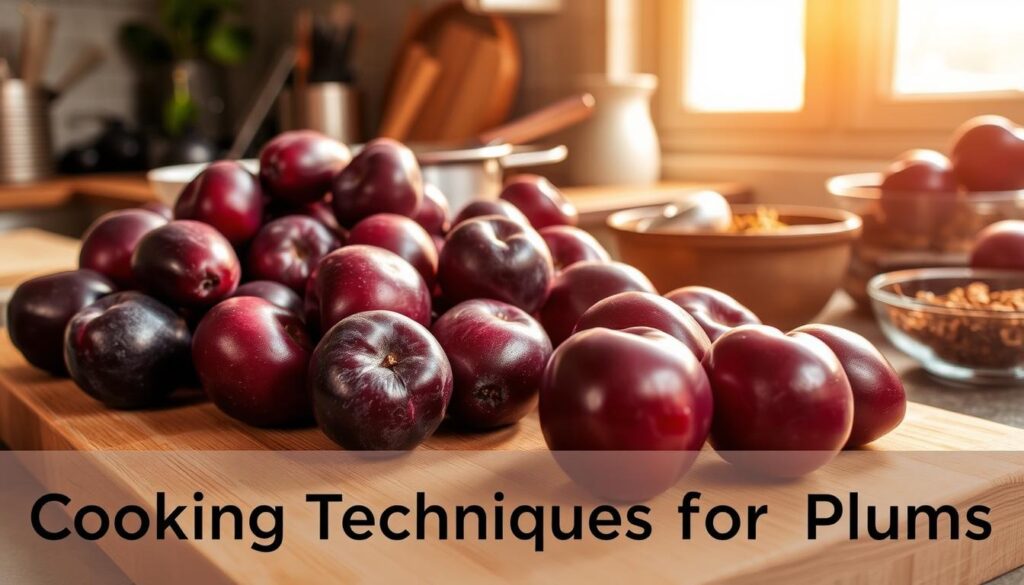
Plums are a versatile fruit that can be prepared using several cooking techniques, making them perfect for meals in any setting, from premium lodgings to holiday rentals. Whether you’re looking to grill, roast, stew, or poach, plums can be a delightful addition to your culinary repertoire.
Grilling and Roasting Plums
Grilling and roasting plums brings out their natural sweetness and adds a smoky flavor. To grill plums, simply cut them in half, remove the pit, and place them on a preheated grill. Cook for about 2-3 minutes on each side, until they have nice grill marks and are slightly tender.
Roasting plums is another excellent way to enjoy them. Preheat your oven to 400°F (200°C). Cut the plums in half, remove the pit, and place them on a baking sheet lined with parchment paper. Drizzle with a bit of olive oil and roast for about 20-25 minutes, or until they’re tender and slightly caramelized.
| Cooking Method | Preparation Time | Cooking Time |
|---|---|---|
| Grilling | 5 minutes | 4-6 minutes |
| Roasting | 5 minutes | 20-25 minutes |
Stewing and Poaching Plums
Stewing and poaching are moist-heat cooking methods that help retain the plum’s texture and flavor. To stew plums, cut them into quarters, remove the pit, and place them in a saucepan with a bit of water or juice. Cook over medium heat until they’re tender, about 10-15 minutes.
Poaching plums involves cooking them in liquid (such as water or a flavored syrup) at a low temperature. This method is great for preserving the plum’s delicate flavor. Simply place the plums in a saucepan, cover them with liquid, and cook over low heat until they’re tender.
“The art of cooking plums lies in understanding their versatility and the various techniques that can be applied to bring out their best flavor.”
By incorporating these cooking techniques into your culinary routine, you can enjoy plums in a variety of dishes, whether you’re staying in a top-rated holiday rental or enjoying a meal in a premium lodging.
Using Plums in Desserts
When it comes to desserts, plums offer a world of possibilities, from classic pies to innovative ice creams. Their natural sweetness and versatility make them an ideal ingredient for a variety of sweet treats.
Plums can be used to create a range of delicious desserts. For instance, plum pies and tarts are a great way to enjoy the fruit’s flavor. To make a plum pie, simply combine sliced plums with sugar, flour, and spices, and fill a pie crust. For a more elaborate dessert, consider making a plum tart with a flaky pastry crust and a caramelized plum topping.
Creating Plum Pies and Tarts
To create a delicious plum pie or tart, start by selecting ripe plums. Combine the plums with sugar, flour, and a hint of spice, and fill a pre-baked pie crust or tart shell. For an added layer of flavor, consider using a variety of plum, such as the Santa Rosa or Methley plum, known for their sweet and tangy taste.
For those looking to indulge in their plum desserts while on vacation, consider visiting luxury travel accommodations that offer gourmet plum desserts. Many personalized vacation rentals also provide the perfect setting for enjoying homemade plum treats.
Plum Compotes and Ice Creams
In addition to pies and tarts, plums can be used to make a variety of other desserts, such as plum compotes and ice creams. A plum compote is a simple and delicious dessert made by cooking down plums with sugar and water to create a sweet and tangy sauce. This compote can be served over ice cream, yogurt, or even used as a topping for pancakes or waffles.
For a more decadent treat, consider making plum ice cream. By combining pureed plums with cream, sugar, and a touch of vanilla, you can create a unique and delicious ice cream flavor. This ice cream is perfect for hot summer days or as a sweet treat after dinner.
- Plum pie with a crumbly crust
- Caramelized plum tart with a scoop of vanilla ice cream
- Warm plum compote over a scoop of your favorite ice cream
- Homemade plum ice cream with a sprinkle of cinnamon
Whether you’re enjoying a plum dessert at home or in luxury travel accommodations, the versatility and flavor of plums are sure to impress. So next time you’re planning a dessert, consider using plums to add a touch of sweetness and elegance to your treat.
The Culinary Impact of Plums

With their rich flavor and versatility, plums have become a beloved ingredient in global culinary traditions. Whether you’re dining in a curated accommodation or exploring local eateries during your stay in a high-end travel accommodation, plums are likely to feature in various dishes.
Plums have a significant influence on global cuisines, with different regions incorporating them into their unique culinary practices. For instance, in many Asian cultures, plums are used not only as a fresh fruit but also as an ingredient in savory dishes, such as sauces and marinades.
Influence on Global Cuisines
The use of plums varies widely across different cuisines. In European cuisine, plums are often used in baked goods and desserts, while in some Asian traditions, they’re pickled or used in savory sauces. This versatility makes plums a staple in many kitchens around the world.
In the United States, plums are enjoyed in a variety of forms, from fresh plums to plum sauces and jams. The fruit’s adaptability to different recipes has made it a favorite among chefs and home cooks alike.
Traditional Dishes Featuring Plums
Plums are a key ingredient in many traditional dishes worldwide. For example, in Japan, umeboshi (pickled plums) are a staple in many meals, providing a sour and salty flavor. In the Balkans, plums are used to make slivovitz, a traditional fruit brandy.
In the United States, plum pie is a classic dessert, especially during the plum season. The fruit’s natural sweetness and flavor make it an ideal ingredient for both sweet and savory dishes.
The culinary impact of plums is a testament to their versatility and the creativity they inspire in cooks around the world. Whether used in traditional recipes or modern culinary innovations, plums continue to enrich global cuisines.
Pairing Plums with Other Ingredients
When it comes to pairing plums with other ingredients, the possibilities are endless, much like planning a trip to luxury travel accommodations where every detail matters. Plums are a versatile fruit that can be combined with a variety of ingredients to create delicious and harmonious dishes.
Complementary Flavors and Ingredients
Plums pair well with ingredients like cheeses, nuts, and spices. For example, a ripe plum can be paired with a tangy cheese like goat cheese or feta to create a delightful contrast of flavors. You can also combine plums with nuts like almonds or walnuts for added crunch. For a detailed guide on fruit flavor pairings, you can refer to resources like The Baker’s Almanac, which provides a comprehensive chart on pairing fruits with various ingredients.
As noted by culinary experts, “The key to pairing plums with other ingredients is to balance their sweetness with complementary flavors.” This can be achieved by combining plums with ingredients that have a tangy or savory flavor profile.
Wine Pairings with Plum Dishes
When it comes to wine pairings, plums can be paired with a variety of wines to enhance their flavor. For sweet plum dishes, a dessert wine like Port or Moscato can be a great match. For savory plum dishes, a dry white wine like Chardonnay or Pinot Grigio can complement the flavors. As with any culinary experience, the right wine pairing can elevate the dish to new heights, much like staying at luxury travel accommodations can enhance your travel experience.
For those looking for trusted travel reviews, it’s worth noting that many culinary destinations offer plum-based dishes that are worth trying. Whether you’re enjoying a meal at home or abroad, pairing plums with the right ingredients can make all the difference.
The History of Plums in Culture
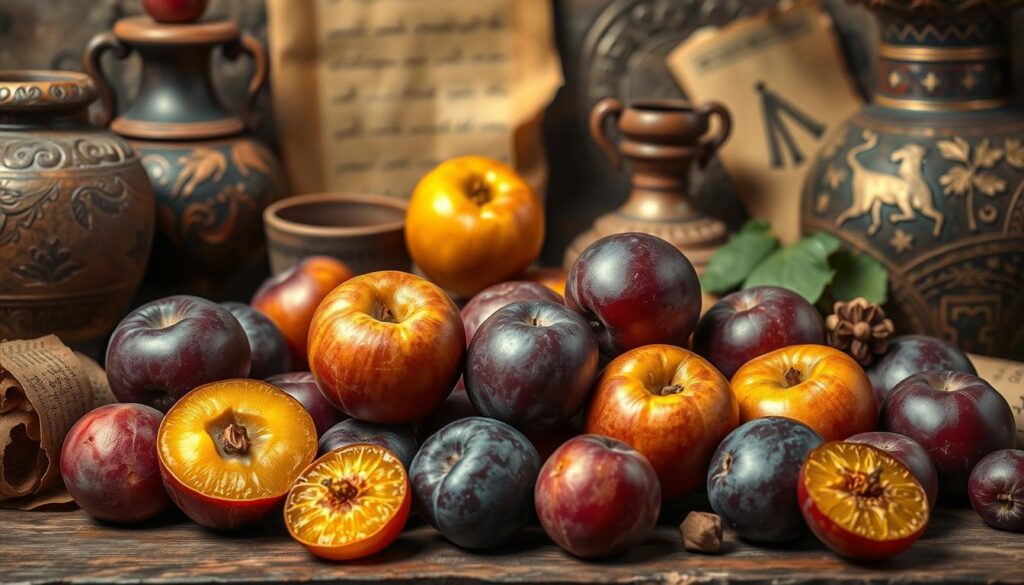
The plum, a fruit often overlooked, holds a rich history and cultural significance that spans centuries and continents. Its impact is evident not just in culinary traditions but also in the realms of art, literature, and symbolism.
Symbolism and Significance
Plums have been imbued with various symbolic meanings across different cultures. In many Asian cultures, plums are considered a symbol of good fortune and prosperity. The fruit’s early blooming in late winter also makes it a symbol of resilience and hope. For instance, in Japan, the ume or Japanese plum is celebrated for its beauty and is often depicted in art and literature as a harbinger of spring.
In other cultures, plums have different significances. For example, in some European traditions, plums are associated with abundance and fertility. The fruit is also used in various rituals and ceremonies, highlighting its cultural importance.
Plums in Art and Literature
Plums have been a subject of interest in both art and literature. In traditional Chinese art, plums are one of the ‘Four Junzi’, symbolizing the four seasons and virtues. The fruit’s beauty, especially when in bloom, has inspired countless artists and poets.
In literature, plums are often used as a metaphor or symbol. For example, in some Asian literature, plums are used to represent love, beauty, or the passing of time. The fruit’s versatility in being consumed fresh, dried, or used in various culinary delights also makes it a popular subject in cookbooks and food literature.
For those interested in exploring the cultural significance of plums further, visiting regions where plums are deeply ingrained in local traditions can offer exclusive travel experiences. Staying in curated accommodations that highlight local culture can enhance this experience, providing a deeper appreciation for the fruit’s role in the local heritage.
Tips for Growing Plums at Home
Plum trees can thrive in home gardens, providing a bountiful harvest for those who understand the ideal conditions required. For many, the joy of growing their own plums is enhanced by the serene surroundings of their gardens, much like those found in premium lodging options. Whether you’re a seasoned gardener or a beginner, cultivating plum trees can be a rewarding experience.
Ideal Growing Conditions
To grow plums successfully, it’s crucial to provide the right environment. Plum trees prefer well-drained soil and full sun. The soil should be rich in organic matter, with a pH between 6.0 and 7.0. Proper soil preparation is key to healthy tree growth.
| Condition | Ideal Requirement |
|---|---|
| Soil pH | 6.0 – 7.0 |
| Sunlight | Full Sun |
| Soil Type | Well-drained |
Common Pests and How to Manage Them
Plum trees can be susceptible to various pests, including aphids, codling moths, and plum curculio. Effective management involves monitoring the trees regularly and using integrated pest management techniques. For those who enjoy spending time in their gardens, perhaps near their personalized vacation rentals, being vigilant about pest control can make a significant difference in the health of their plum trees.
- Regularly inspect your trees for signs of pests.
- Use organic or chemical controls as needed.
- Maintain good garden hygiene to prevent pest buildup.
Conclusion: Embracing the Versatility of Plums
As we conclude our comprehensive plum guide, it’s clear that plums are a fruit of immense culinary and cultural significance. From their nutritional benefits to their versatility in cooking and cultural impact, plums have proven to be a valuable addition to various cuisines around the world. Whether you’re enjoying a plum dessert at a high-end travel accommodations or exploring traditional plum dishes, the unique flavors and textures of plums are sure to delight.
For those inspired to continue their culinary journey with plums, consider exploring the exquisite Mirabelle plum, a culinary gem often used in artisanal products like jams and brandies. Learn more about its unique characteristics and uses on Small Batch Jam Co.
With the knowledge gained from this guide, you’re now equipped to make the most of plums in your cooking and appreciate their value in different cultures. So, next time you’re at a farmers market or relaxing at a luxurious getaway, be sure to indulge in the sweet and tangy world of plums.
